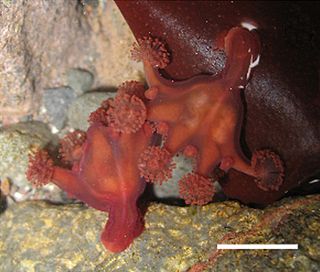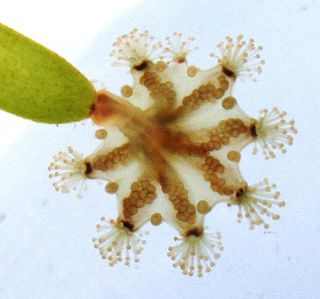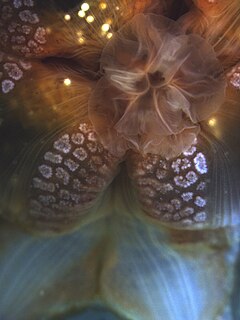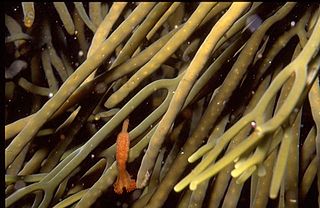 W
WStaurozoa is a class of Medusozoa, jellyfishes and hydrozoans. It has one extant order: Stauromedusae. A fossil group called Conulariida has been proposed as a second order, although this is highly speculative. The extinct order is largely unknown and described as a possibly cnidarian clade of marine life with shell-like structures, the Conulariida. Staurozoans are small animals that live in marine environments, usually attached to seaweeds, rocks, or gravel. They have a large antitropical distribution, a majority found in boreal or polar, near-shore, and shallow waters. Few staurozoans are found in warmer tropical and subtropical water environments of the Atlantic, Indian, and Pacific Ocean basins, but most are known from the Northern Hemisphere. Over the years their number of species has increased, thus right now it is said to have an estimated 50 species.
 W
WStauromedusae are the stalked jellyfishes. They are the sole living members of the class Staurozoa, and belong to the medusozoa subphylum of Cnidaria. They are unique among medusa jellyfish in that they do not have an alternation of polyp and medusa life cycle phases but are instead interpreted as an attached medusa stage, with a life style more resembling that of polypoid forms. They have a generally trumpet-shaped body, oriented upside-down in comparison with other jellyfish, with the tentacles projecting upwards, and the stalk located in the centre of the umbrella.
 W
WAmyostaurida is a suborder of jellyfishes. It contains two families.
 W
WThe bell trumpet jelly, is a species of stalked jellyfish in the family Lipkeidae.
 W
WCalvadosia is a genus of stalked jellyfish in the order Stauromedusae. It is the only genus in the monotypic family Kishinouyeidae.
 W
WCalvadosia corbini is a stalked jellyfish species in the family Kishinouyeidae from the tropical western Atlantic. The species is named after Peter Corbin, a marine biologist noted for his extensive work on Atlantic Stauromedusae.
 W
WCraterolophus is a genus of jellyfish. It is the only genus in the monotypic family Craterolophidae. Species of this genus are characterized by the absence of primary tentacles as well as the absence of longitudinal muscles running along the peduncle.
 W
WHaliclystidae is a family of stalked jellyfish in the order Stauromedusae.
 W
WHaliclystus is a genus of stalked jellyfish that contains 11 species and one nomen nudum. It is the largest genus in the order Stauromedusae. Members of this genus are found in the Pacific, Atlantic, Indian, Arctic, and Southern oceans. Two members of this genus, Haliclystus kerguelensis and Haliclystus antarcticus, are found in the Southern hemisphere only. The remaining 9 members are found in the Northern hemisphere only.
 W
WHaliclystus antarcticus is a stalked jellyfish which lives on rocky shore lines in the Southern hemisphere.
 W
WHaliclystus auricula is a stalked jellyfish found in the Northern hemisphere. It is the type species for its genus.
 W
WHaliclystus octoradiatus, common name spotted kaleidoscope jellyfish, is a stalked jellyfish in the family Lucernariidae.
 W
WHaliclystus sanjuanensis is a species of small (~4 cm) stalked jellyfish found in the Pacific Ocean along the west coast of North America. This species can be found in shallow waters at low tide on soft substrates such as seagrass (Phyllospadix). A variety of colour morphs can be found ranging from yellow-green to red. Haliclystus sanjuanensis remains undescribed officially, despite sequence data establishing it as a distinct taxon.
 W
WHaliclystus stejnegeri is a species of stalked jellyfish in the family Haliclystidae.
 W
WLipkea is a genus of stalked jellyfish. It is the only genus in the monotypic family Lipkeidae. Lipkea species lack tentacles at the end of their bell.
 W
WLucernaria quadricornis is a species of stalked jellyfish in the family Lucernariidae.
 W
WLucernariidae is a family of stalked jellyfish containing two genera.
 W
WManania are a genus of stalked jellyfish in the family Haliclystidae.
 W
WManania handi is a species of stalked jellyfish found in the Pacific Ocean along the west coast of North America. This species can be found in shallow waters at low tide on soft substrates such as seagrass (Phyllospadix), but the related M. gwilliami have also been recovered at depths of >10 metres. This may reflect that intertidal specimens represent the fringes of a population that is typically more commonly found in the subtidal zone.
 W
WThe stalked trumpet jelly, is a species of stalked jellyfish in the family Depastridae. It is the only member of the genus Depastromorpha.